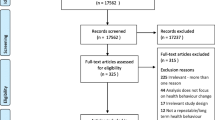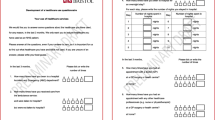Abstract
Patient-reported outcome measures (PROMs) are frequently used in research to reflect the patient’s perspective. In this commentary, I argue that further improvements can be made in how we develop and evaluate PROMs by viewing assessment as a type of conversation. Philosophically speaking, a PROM assessment can be conceptualized as a formal conversation that serves as a model of an informal, longer, and more nuanced conversation with a research participant about their health experience. Psychologically speaking, evidence from research in survey methodology and discursive psychology shows that respondents to self-report measures behave in ways consistent with the idea that they are doing their best to participate in a conversation, albeit an unusual one. Several suggestions are offered for creating a better conversational context through study materials and PROM instructions, and by improving the yield of cognitive interviews. It is hoped that this commentary can stimulate further discussions in our field regarding how to integrate insights about the conversational nature of assessment from survey research and discursive psychology to better reflect the patient’s voice in research.


Similar content being viewed by others
References
McClimans, L. (2010). Towards self-determination in quality of life research: A dialogic approach. Medicine, Health Care and Philosophy,13(1), 67–76. https://doi.org/10.1007/s11019-009-9195-x.
Markus, K. A., & Borsboom, D. (2013). Frontiers of test validity theory. New York: Routledge.
Harré, R. (2002). Cognitive Science. Thousand Oaks, CA: Sage.
Harré, R. (1998). Recovering the experiment. Philosophy,73(285), 353–377. https://doi.org/10.2307/3751988.
Gobo, G., & Mauceri, S. (2014). Constructing survey data. Thousand Oaks: Sage.
Schwarz, N., & International Statistical Review/Revue Internationale de Statistique. (1995). What respondents learn from questionnaires: The survey interview and the logic of conversation. JSTOR,63(2), 153. https://doi.org/10.2307/1403610.
Schwarz, N. (2010). Measurement as cooperative communication: What research participants learn from questionnaires. In G. Walford, E. Tucker, & M. Viswanathan (Eds.), The SAGE handbook of measurement (pp. 43–61). Thousand Oaks, CA: Sage.
Harré, R., & Stearns, P. (Eds.). (1995). Discursive psychology in practice. Thousand Oaks: Sage.
Harré, R., & Gillett, G. (1994). The discursive mind. Thousand Oaks, CA: Sage.
Grice, P. (1989). Logic and conversation. In H. P. Grice (Ed.), Studies in the way of words (pp. 22–57). Cambridge, MA: Harvard University Press.
Galesic, M., & Tourangeau, R. (2007). What is sexual harassment? It depends on who asks! Framing effects on survey responses. Applied Cognitive Psychology,21(2), 189–202. https://doi.org/10.1002/acp.1336.
Schwarz, N., Knäuper, B., Hippler, H. J., Noelle-Neumann, E., & Clark, F. (1991). Rating scales: Numeric values may change the meaning of scale labels. Public Opinion Quarterly,55, 570–582.
Schwarz, N. (1999). Frequency reports of physical symptoms and health behaviors: How the questionnaire determines the results. In D. C. Park, R. W. Morrell, & K. Shifren (Eds.), Processing of medical information in aging patients (pp. 93–108). New York: Academic Press.
Schwarz, N., Bless, H., Bohner, G., Harlacher, U., & Kellenbenz, M. (1991). Response scales as frames of reference: The impact of frequency range on diagnostic judgements. Applied Cognitive Psychology,5(1), 37–49. https://doi.org/10.1002/acp.2350050104.
Austin, J. L. (1962). How to do things with words (2nd ed.). Cambridge, MA: Harvard University Press.
Cella, D., Hahn, E. A., & Dineen, K. (2002). Meaningful change in cancer-specific quality of life scores: Differences between improvement and worsening. Quality of Life Research,11(3), 207–221.
Sulmasy, D. P., Astrow, A. B., He, M. K., Seils, D. M., Meropol, N. J., Micco, E., et al. (2010). The culture of faith and hope: Patients’ justifications for their high estimations of expected therapeutic benefit when enrolling in early phase oncology trials. Cancer,116(15), 3702–3711. https://doi.org/10.1002/cncr.25201.
McClimans, L. (2010). A theoretical framework for patient-reported outcome measures. Theoretical Medicine and Bioethics,31(3), 225–240. https://doi.org/10.1007/s11017-010-9142-0.
DeWalt, D. A., Rothrock, N., Yount, S., & Stone, A. A. (2007). Evaluation of item candidates: The PROMIS qualitative item review. Medical Care,45(Suppl 1), S12–S21. https://doi.org/10.1097/01.mlr.0000254567.79743.e2.
Weinfurt, K. P. (2013). Understanding what participants in empirical bioethical studies mean: Historical cautions from William James and Ludwig Wittgenstein. AJOB Primary Research,4(3), 49–54. https://doi.org/10.1080/21507716.2013.807893.
Fortune-Greeley, A. K., Flynn, K. E., Jeffery, D. D., Williams, M. S., Keefe, F. J., Reeve, B. B., et al. (2009). Using cognitive interviews to evaluate items for measuring sexual functioning across cancer populations: Improvements and remaining challenges. Quality of Life Research,18(8), 1085–1093. https://doi.org/10.1007/s11136-009-9523-x.
Acknowledgements
I am grateful to my colleagues who provided invaluable feedback on earlier drafts of this paper: Theresa Coles, PhD; Karon Cook, PhD; Kathryn Flynn, PhD; Bryce Reeve, PhD; Christy Zigler, PhD; and Nancy Zucker, PhD.
Author information
Authors and Affiliations
Contributions
KW: Conceptualization and drafting of final manuscript.
Corresponding author
Ethics declarations
Conflict of interest
The author declares that he has no conflict of interest.
Research involving human and animal participants
This article does not contain any studies with human participants performed by any of the authors.
Additional information
Publisher's Note
Springer Nature remains neutral with regard to jurisdictional claims in published maps and institutional affiliations.
Rights and permissions
About this article
Cite this article
Weinfurt, K.P. Viewing assessments of patient-reported heath status as conversations: Implications for developing and evaluating patient-reported outcome measures. Qual Life Res 28, 3395–3401 (2019). https://doi.org/10.1007/s11136-019-02285-8
Accepted:
Published:
Issue Date:
DOI: https://doi.org/10.1007/s11136-019-02285-8




